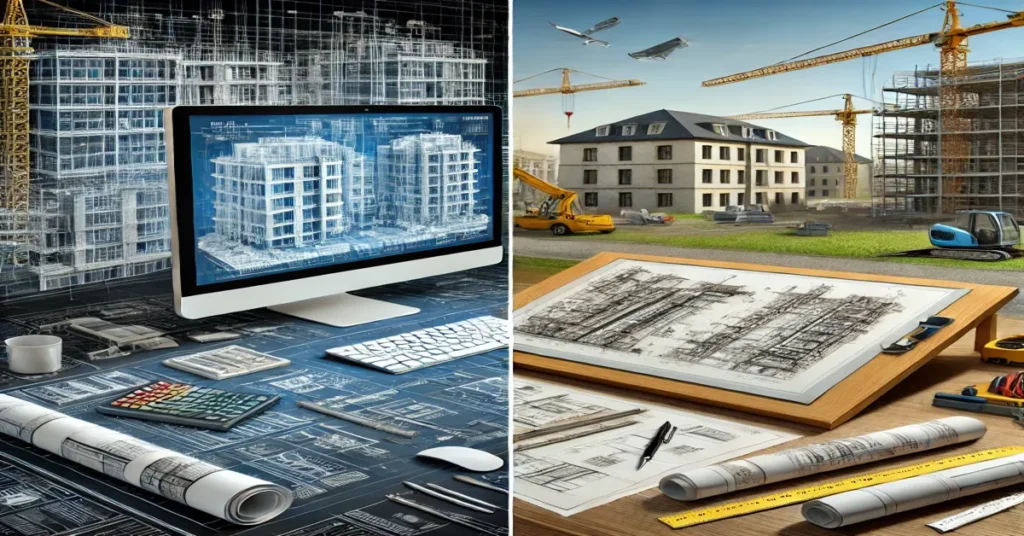In the world of construction, the way we pattern and plan projects has evolved importantly over the years. Two major approaches are ordinarily discussed: Building Information Modeling BIM and formal drafting. Both methods have their strengths and weaknesses, and choosing the right one could affect the efficiency and success of a project. In this blog, we’ll liken BIM and formal drafting with Plumbing Shop Drawing Consulting to help you learn what might have been meliorate for your building projects.
What is Traditional Drafting?
Traditional drafting is the ferment of creating building drawings by hand or using basic computer aided pattern CAD tools. These drawings acknowledge floor plans as well as elevations, and sections of buildings. Traditional drafting relies on 2D representations, meaning that each drawing provides a flat view of clear-cut aspects of the building.
Advantages of Traditional Drafting
- Simplicity: Traditional drafting is straight and easy to understand. For many years, it was the received commercial for creating building drawings.
- Cost: If you already had basic CAD tools as well as formal drafting might have been more cost-efficient compared to investing in BIM software.
- Flexibility: Traditional drawings can be created quickly and easily, which is useful when making quick changes or adjustments.
Disadvantages of Traditional Drafting
- Limited Visualization: Traditional drafting only offers 2D views of a project. It’s challenging to learn how clear-cut parts of the building interact in three dimensions.
- Errors and Revisions: If changes are needed, formal drawings must be revised manually. This could lead to errors and inconsistencies, particularly if updates are not correctly communicated.
- Coordination Issues: With formal drafting, coordinating between clear-cut trades like exciting and plumbing can be difficult. Each trade may have worked from different sets of drawings, leading to effectiveness conflicts during construction.
What is Building Information Modeling BIM?
Building Information Modeling BIM is a modern-day admittance to designing and managing building projects. BIM uses 3D models to make detailed representations of a building. These models included not only the building’s real aspects but also data about materials, systems, and even projected schedules.
Advantages of BIM
- 3D Visualization: BIM provides an all-encompassing 3D view of the intact building. This allows stakeholders to have apprehended the pattern and how clear-cut elements fit together.
- Enhanced Collaboration: BIM models can be accessed and updated by aggregated team members simultaneously. This improves communication and reduces the risk of errors.
- Clash Detection: BIM parcel could mechanically observe clashes or conflicts between clear-cut systems like HVAC and plumbing before building begins as well as minimize expensive changes during the building phase.
- Cost and Time Efficiency: By simulating the building process with BIM Outsourcing Services, BIM could help identify effectiveness issued former, leading to more correct cost estimates and quicker learning completion.
Disadvantages of BIM
- High Initial Cost: BIM paper can be expensive as well, there may be additive costs for training staff to use it effectively.
- Complexity: BIM involves a learning curve and can be compound to use. Teams must be skilled in navigating the parcel to fully welfare from its features.
- Data Management: Managing the large amounts of data generated by BIM can be challenging. Proper data direction practices are demanded to keep the model organized and accurate.
Comparing BIM and Traditional Drafting
To settle BIM or formal drafting is meliorate for your project as well as initiate to view single factors:
Project Size and Complexity
- Small Projects: For smaller, less compound projects, formal drafting might have been insufficient. The simplicity and lower cost can be advantageous.
- Large Projects: For large or compound projects, BIM was often the meliorate choice. Its 3D modeling and coordination features could deal with the complexity and help deal with aggregated stakeholders more effectively.
Budget
- Tight Budgets: If budget constraints are significant as well as formal drafting may be the more low-priced option. It requires fewer resources and the first investment.
- Flexible Budgets: If you have the budget to charge in BIM, it could allow semipermanent savings a meliorate learning direction, and fewer errors.
Project Team
- Experienced Team: If your team is experienced with BIM or willing to charge in training, BIM could offer physical benefits in terms of coalition and efficiency.
- Traditional Skills: If your team is more associated with formal drafting methods as well as it might have been more hard-nosed to stick with what they know unless there’s a compelling fence to switch.
Case Studies
Case Study 1: Traditional Drafting Success
A small act learned used formal drafting effectively. The learn had a primary pattern and a tight budget. The team was experienced with hand drawing techniques, and the learning was completed on time and inside budget without the need for advanced technology.
Case Study 2: BIM Success
In contrast, a large commercialized building learn utilized BIM to great success. The complexity of the building required coordination between trades, and BIM’s clash contactable and 3D visualization helped streamline the process. The Wood Framing Estimating fewer conflicts and delays, leading to a more efficacious build and lower boilersuit costs.
Conclusion
Choosing between BIM and formal drafting depends on the specifics of your project, budget, and team. Traditional drafting offers simplicity and cost-effectiveness for smaller projects, while BIM provides advanced features that could greatly welfare large and more compound projects. By understanding the strengths and weaknesses of each method, you could make an informed conclusion that aligns with your project’s needs and goals. Whether you prefer BIM or formal drafting, the key is to check that your admittance supports efficacious planning, coordination, and slaying of your building projects.







